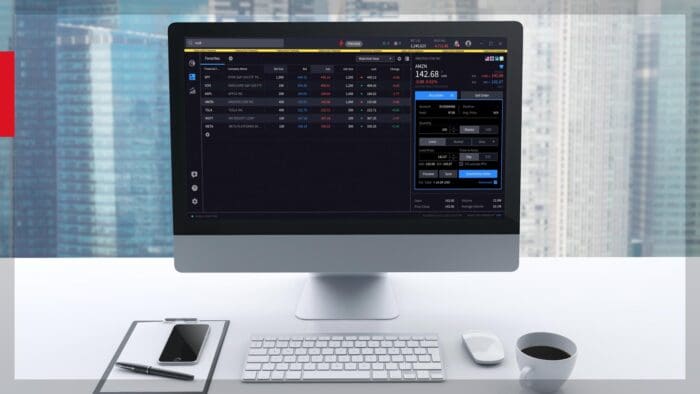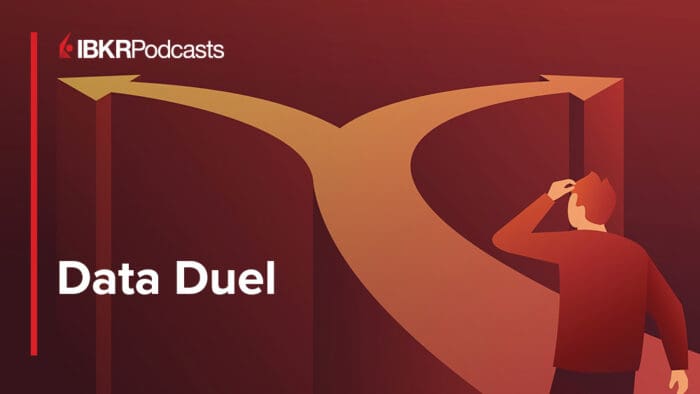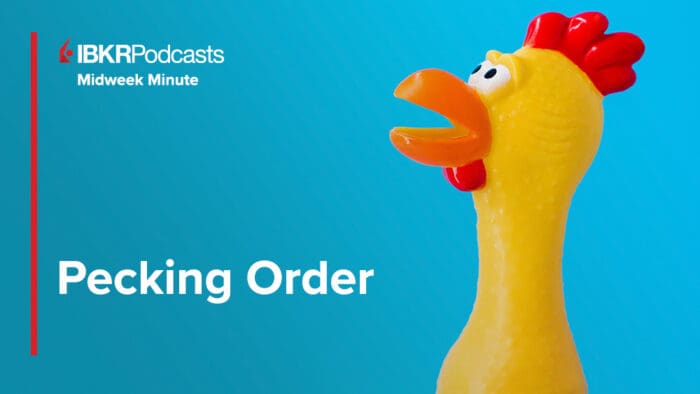Navigate the twists and turns of complex option strategies as Jeff Praissman sits down with Market Chameleons’ Dmitry Paramanik and Will McBride. From skews and spreads to rolling techniques, discover how multi‑leg index trades can unlock new insights and opportunities in any market.
Summary – IBKR Podcasts Ep. 275
The following is a summary of a live audio recording and may contain errors in spelling or grammar. Although IBKR has edited for clarity no material changes have been made.
Jeff Praissman
Hi everyone. This is Jeff Praissman with the Interactive Brokers Podcast. It’s my pleasure to welcome back to our podcast studio Market Chameleons’ Dmitry Paramanik and Will McBride.
Hey guys, how are you?
Dmitry Paramanik
Hey Jeff. How are you doing?
Will McBride
Hey Jeff. Thanks for having us.
Jeff Praissman
I am doing great. I’m doing great. And you guys just finished up a great webinar, and I’m happy to have you guys come into our podcast studio—as you do after each time you do a webinar—and we’ll take a little bit deeper or a different dive, but definitely continuing to explore what we just talked about. Maybe you could give our listeners just a summary of what this podcast is going to be.
Dmitry Paramanik
Yeah. We’re going to talk about multi-leg option trades, particularly for index options. So this would be something like SPX, VIX, and NDX—securities and options that trade on them.
Jeff Praissman
Great. And Dmitry, what makes index options particularly attractive for multi-leg strategies, say compared to individual stock options, and how does this impact your trade?
Dmitry Paramanik
Yeah. So the index options are different in a couple ways from single securities listed on the exchange, where those are usually American-style exercise—where you would receive delivery of the underlying asset. Index options are a little bit different because they’re European-style, cash-settled, and they track an index, usually used for macro or systemic hedging. SPX is like the S&P 500. VIX is the implied volatility index.
What makes the European and cash-settled unique from the other deliverables is that some people prefer that because they don’t have to take delivery of an asset. For example, with stock, if the option is in the money at expiration, you’re going to have the underlying asset delivered to you. Here, it’s cash-settled, so you don’t have the early exercise component or the delivery of the asset. That makes it unique and attractive to many traders.
Another thing is that they tend to be more liquid because lots of institutions will use these instruments for risk mitigation and hedging overall portfolio risk.
Jeff Praissman
And could you walk us through a specific example of how institutional traders use, say, vertical spreads versus iron condors to express market views, and how can we identify these patterns?
Dmitry Paramanik
Yes, so that’s a good question, because when we talk about multi-leg trades, these are trades that involve some type of a spread—or more than one leg to the option trade: two, three, four legs. By doing these strategies, usually that could express a different viewpoint. For example, a bull call spread could express a particular directional viewpoint.
But, for example, an iron condor would be more of an expression of movement in a stock in either direction—either lack of, or an expected large move. Or you could have some kind of strategy where you’re looking at an implied volatility type of outlook instead of just a directional one, or one based on lack of move.
It is a good question. The thing with option trades is that you’re forced to look at the individual trades, look at the underlying conditions and fields that are populated from the exchanges, and stitch those together. The exchange doesn’t tell you, “Here’s a bull spread, here’s an iron condor.” They give you the individual legs, but they do give you information that they’re related, because they’ll be tagged multi-leg trades. You see the exchange and timestamp and so forth. So you have to go in there and make an inference or interpretation based on the surrounding data that you’re looking at.
It’s not always exact. It doesn’t mean you’ll be exactly correct, but most likely, when you’re looking at it, you can figure out what the strategy is. I would say the majority of the time, you can make a good inference.
Jeff Praissman
And how would you recommend traders balance the benefits of those extended trading hours in, say, SPX and VIX options with the unique challenges of managing this overnight risk in multi-leg trades?
Dmitry Paramanik
Yeah, so that’s another benefit which I did forget to mention—SPX and VIX trade in extended hours. Right now, options on securities listed on the exchange trade during regular trading hours, from 9:30 to 4:00, or 4:15/4:30 for some ETFs.
But index options actually have extended hours. You can trade in pre-market and after hours, and I think on a Sunday they’re open. So they’re not completely 24/7, but they do have a much wider trading availability—the trading times they are available to trade. That can be beneficial for those traders who are trying to access options during extended hours or trying to manage systemic risk and are able to trade around those hours.
So that is a benefit to them right now. Maybe later it will change, but certainly other stocks right now don’t have that.
Jeff Praissman
That makes sense. Having a little bit of extra time available to manage that risk has got to be helpful. What are the key differences between screening for multi-leg trades versus traditional technical analysis, and how can traders incorporate both to effectively manage their trades?
Dmitry Paramanik
Yeah. So technical analysis is a screen—basically on historical stock movement or indicators based on stock trading, stock activity, stock volume, price action. The multi-leg trades—this is looking at option trades that are strategies, basically, and those strategies can present a certain outlook.
Obviously, option trades—or options—are forward-looking instruments. Technical analysis is looking at historical data analysis for some kind of a technical indicator. So one has to do with historical stock moves. Screening for multi-leg trades is looking at the current trades and trying to interpret what type of viewpoint or outlook the market is targeting.
Jeff Praissman
And how do you interpret changes in implied volatility skew when you’re analyzing multi-leg trades versus a single leg? And what signals should traders look for in different scenarios?
Dmitry Paramanik
Yeah, so because the multi-leg trades do involve more than one leg—usually a spread—the spread could be a vertical spread within the same expiration, which would involve different strikes with different implied volatilities. And those implied volatilities may have a skew, because you’re buying one option and selling a different option.
If those have different implied volatilities, we call that a skew—the relationship between the two different strikes. We could also look at a horizontal skew, where it could be a time spread—where you have multiple legs, but one is in one expiration and then you have a buy or sell in the opposite direction in a different expiration. Those have different implied volatilities. They could even have a diagonal calendar spread.
So when we look at that and see how it’s impacting the skew, if you have trades that are simultaneously on different strikes or different expirations, then we can observe what the implied volatilities were on those legs. What is the difference? What type of skew are we looking at? And we can compare that to historical benchmarks.
That’s another way into the question—to look at how the trades are impacting the implied volatility skew across different strikes and expirations.
Jeff Praissman
Yeah. And you mentioned diagonal and calendar spreads, and it plays perfectly into my next question. I was going to ask you: what role do these diagonal spreads play in managing that exposure across expirations as they’re rolling it? And how can traders screen for, if there is even one, optimal roll timing opportunity?
Dmitry Paramanik
Yeah. And what’s interesting about the index options is because they’re used a lot of times for hedging portfolio risk—or hedging maybe events—but what you do see is a lot of rolling going on. Because you have an option or strategy that perhaps is hedging or mitigating some risk, but those options are going to expire, you’re rolling to the next option.
There are also strategies where you’re trying to have it on a constant maturity and may roll it as well. If you’re trying to, let’s say, have a position between 20–30 days or something, you have to roll them. So there’s a lot of that going on—where you have to roll into the next option.
It could even be from strike to strike—it might not be from time. But if you’re trying to hedge a certain percentage away as the stock moves, you’re rolling to a different strike, whether it’s getting further out of the money or in the money. Sometimes we do see that type of activity where it’s not necessarily a spread but a roll.
You wouldn’t know that at that time; you would have to combine more data, like the changes in open interest, which wouldn’t come out until the following day because open interest just updates overnight. But that is an interesting question, and that does happen often enough in these types of instruments.
Jeff Praissman
And how do you distinguish between genuine institutional activity and retail trader behavior when analyzing these multi-leg trade flows? Is it just—
Dmitry Paramanik
Yeah, I think it’s basically the volume. If you’re looking at a very large volume trade, then the assumption is this is not a typical retail trader who would put on such a large dollar-value trade or even volume trade. And then if you’re seeing very small trades with not much around it, then you may assume that’s just a retail-sized trade.
A large institution would not likely just trade one contract and go away. So yeah—you have to make that inference based on volume.
Jeff Praissman
Got it. Got it. And are you able to share a specific case study of using multi-leg index options to hedge systematic risk, maybe during periods of high market stress, and how the screening process helped identify that?
Dmitry Paramanik
Yeah, with the options, one of the things to look for, potentially, is where things are happening either before an expected event—it could be an upcoming Fed meeting with interest rates—or it could be post-event, where something happened and then, you know, the market… like new tariffs were announced or something.
So if you know an upcoming event or something just happened and you’re looking at the options market, you get a sense and observe what that sentiment is like through the trading activity. What was the reaction to it? What are the traders doing? Are they bidding up implied volatility? Or are they crushing volatility? Which strikes are they targeting? Which expirations are they targeting?
So it gives you a good kind of connection between an event that impacts the markets as a whole, and then you can correlate that with: is there any unusual option activity?
Jeff Praissman
And I imagine there’s a lot of metrics you look at when monitoring and screening these multi-leg trades. What are some of the more critical ones, and how do you prioritize them? Does it change depending on the market environments?
Dmitry Paramanik
Yeah, I mean, I think that in general the most critical ones are—I’d say the ones you’ll probably start out with, the metrics you look for when screening for actual multi‑leg trades. You’re looking at volume, right? Volume is a big one. If there’s a lot of trading activity, that may catch your interest or make you wonder what’s going on here—should I analyze it more?
And then price action—where you’re looking at what prices these strategies are trading at, and starting to analyze them from different perspectives. You could analyze them relative to the bid/ask spread. You could analyze them relative to the implied volatilities. But you’re trying to compare the price to some value or some metric that you have, depending on what you’re trying to analyze.
But the biggest two, right, are volume and price—and how you translate that price into a value that you can analyze.
Jeff Praissman
And Dmitry, how can traders effectively combine these quantitative screening tools with qualitative market analysis to create an approach to identifying these multi‑leg opportunities? Because I imagine the more they’re looking, the more information we’re looking at, the better. We always kind of go back to that—where you can’t just look at one. It’s not a vacuum. You can’t just look at one item. It’s got to be a…
Dmitry Paramanik
Yeah, exactly. You’ll look at a combination of factors. For example, one of the things that traders look for is liquidity—the liquidity of the market. So the quantitative approach would be: how much volume is trading? Is there a lot of activity? If there’s a lot of volume trading in something, then the idea there is that there’s a good price discovery mechanism because you have lots of back‑and‑forth or lots of big trades, which helps with the price discovery.
And the qualitative part of it is, if we’re looking at liquidity besides volume, we want to see what the markets’ bid/asks look like—for example, the bid/ask spreads and where the trades are happening relative to the bid/ask spreads. If the bid/ask spreads are very narrow, that suggests that there’s good liquidity there because the price of getting in and out of a trade becomes less expensive.
And of course, where is the trade price relative to the bid/ask? If you’re trading right at the midpoint, that means that you’re getting it at that market fair value. You’re getting good quality executions where you’re not paying up or selling down when you’re trying to get in and out of it.
So you would have to combine those types of things to get a good sense of the liquidity of the market and the cost of trading in that market.
Jeff Praissman
And any final thoughts you’d like to leave our…
Dmitry Paramanik
Yeah. I think that, as always, when you’re looking at options trading, mitigating risk, and looking for opportunities, you want to be able to explore as many different available tools out there that will help you—give you an edge, give you more insights, maybe give you opportunities or ways to hedge more efficiently, maybe even things you haven’t thought of before.
So when you’re looking at the markets as a whole, looking at those index options and looking at those index spreads could really be beneficial. It’s something that people should keep an eye on or consider in their overall trading strategies.
Jeff Praissman
This has been great as always. And for our listeners, you can catch more of Will and Dmitry on their morning YouTube show. You can catch them the second Tuesday of every month—they put on a great options‑related webinar for Interactive Brokers. You don’t even need to be a client of Interactive Brokers. You can just sign up for it. Go to our website, go to Education, find great material from those guys, or go to MarketChameleon.com and look at their service. Guys, thanks so much. Really appreciate it.
Will McBride
Thanks for having us. We’ll see you next month.
Dmitry Paramanik
Bye, everyone.
Jeff Praissman
You got it.
Disclosure: Interactive Brokers
The analysis in this material is provided for information only and is not and should not be construed as an offer to sell or the solicitation of an offer to buy any security. To the extent that this material discusses general market activity, industry or sector trends or other broad-based economic or political conditions, it should not be construed as research or investment advice. To the extent that it includes references to specific securities, commodities, currencies, or other instruments, those references do not constitute a recommendation by IBKR to buy, sell or hold such investments. This material does not and is not intended to take into account the particular financial conditions, investment objectives or requirements of individual customers. Before acting on this material, you should consider whether it is suitable for your particular circumstances and, as necessary, seek professional advice.
The views and opinions expressed herein are those of the author and do not necessarily reflect the views of Interactive Brokers, its affiliates, or its employees.
Disclosure: Market Chameleon
The information provided on MarketChameleon is for educational and informational purposes only. It should not be considered as financial or investment advice. Trading and investing in financial markets involve risks, and individuals should carefully consider their own financial situation and consult with a professional advisor before making any investment decisions. MarketChameleon does not guarantee the accuracy, completeness, or reliability of the information provided, and users acknowledge that any reliance on such information is at their own risk. MarketChameleon is not responsible for any losses or damages resulting from the use of the platform or the information provided therein. The 7-day free trial is offered for evaluation purposes only, and users are under no obligation to continue using the service after the trial period.
Disclosure: Options Trading
Options involve risk and are not suitable for all investors. For information on the uses and risks of options, you can obtain a copy of the Options Clearing Corporation risk disclosure document titled Characteristics and Risks of Standardized Options by going to the following link ibkr.com/occ. Multiple leg strategies, including spreads, will incur multiple transaction costs.

















Join The Conversation
For specific platform feedback and suggestions, please submit it directly to our team using these instructions.
If you have an account-specific question or concern, please reach out to Client Services.
We encourage you to look through our FAQs before posting. Your question may already be covered!